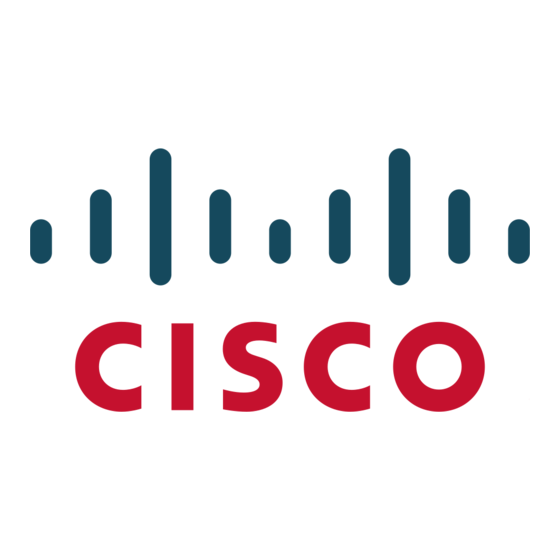Cisco 2975 - Catalyst LAN Base Switch Veri Sayfası - Sayfa 8
Anahtar Cisco 2975 - Catalyst LAN Base Switch için çevrimiçi göz atın veya pdf Veri Sayfası indirin. Cisco 2975 - Catalyst LAN Base Switch 14 sayfaları. Stackable switch
Ayrıca Cisco 2975 - Catalyst LAN Base Switch için: Başlangıç Kılavuzu (17 sayfalar), Ürün Bülteni (2 sayfalar), Broşür (19 sayfalar)

© 2008 Cisco Systems, Inc. All rights reserved. This document is Cisco Public Information.
Availability and Scalability
● IEEE 802.1x Voice-aware security disables the offending data VLAN when a violation is detected
Superior
Redundancy for
without affecting Voice VLAN on the same switch port
Fault Backup
● IEEE 802.1x readiness check determines readiness of connected end hosts, before configuring
802.1x on the switch.
● Cisco UplinkFast and BackboneFast technologies help ensure quick failover recovery, enhancing
overall network stability and reliability.
● IEEE 802.1w Rapid Spanning Tree Protocol provides rapid spanning-tree convergence independent
of spanning-tree timers and the benefit of distributed processing.
● Per-VLAN Rapid Spanning Tree Plus (PVRST+) allows rapid spanning-tree reconvergence on a
per-VLAN spanning-tree basis, without requiring the implementation of spanning-tree instances.
● Clustering with single IP address management and SNMP and SYSLOG proxy for up to 16
switches. Clustering command-switch redundancy allows designation of a backup command switch
that takes over if the primary command switch fails.
● Unidirectional Link Detection Protocol (UDLD) and Aggressive UDLD allow unidirectional links to be
detected and disabled to avoid problems such as spanning-tree loops.
● Switch port autorecovery (errdisable) automatically attempts to re-enable a link that is disabled
because of a network error.
● Cisco Redundant Power System 2300 (RPS 2300) support provides superior internal power-source
redundancy for up to six Cisco networking devices, resulting in improved fault tolerance and
network uptime.
● Bandwidth aggregation up to 8 Gbps through Cisco Gigabit EtherChannel technology and up to 800
Mbps through Cisco Fast EtherChannel technology enhances fault tolerance and offers higher-
speed aggregated bandwidth between switches and to routers and individual servers.
● Flex Links provides link redundancy with convergence time 100ms without requiring Spanning Tree
Protocol.
● VLAN Flex Links load balancing improves network throughput by utilizing both links for traffic
distribution for different VLANs.
● Link State Tracking provides Layer 2 redundancy in the network when used in conjunction with
server or programmable logic controller (PLC) network interface card (NIC) adapter teaming.
● Per-port broadcast, multicast, and unicast storm control prevents faulty end stations from degrading
Integrated Cisco
IOS Software
overall systems performance.
Features for
● IEEE 802.1d Spanning Tree Protocol support for redundant backbone connections and loop-free
Bandwidth
networks simplifies network configuration and improves fault tolerance.
Optimization
● PVST+ allows for Layer 2 load sharing on redundant links to efficiently use the extra capacity
inherent in a redundant design.
● IEEE 802.1s Multiple Spanning Tree Protocol allows a spanning-tree instance per VLAN, enabling
Layer 2 load sharing on redundant links.
● Egress committed rate (ECR) guarantee provides load balancing and redundancy.
● Local Proxy Address Resolution Protocol (ARP) works in conjunction with Private VLAN Edge to
minimize broadcasts and maximize available bandwidth.
● VLAN1 minimization allows VLAN1 to be disabled on any individual VLAN trunk link.
● VLAN Trunking Protocol (VTP) pruning limits bandwidth consumption on VTP trunks by flooding
broadcast traffic only on trunk links required to reach the destination devices.
● Internet Group Management Protocol (IGMP) version 3 snooping provides fast client joins and
leaves of multicast streams and limits bandwidth-intensive video traffic to only the requestors.
● IGMP filtering provides multicast authentication by filtering out no subscribers and limits the number
of concurrent multicast streams available per port.
● Multicast VLAN registration (MVR) continuously sends multicast streams in a multicast VLAN while
isolating e streams from subscriber VLANs for bandwidth and security reasons.
Data Sheet
Page 8 of 14
